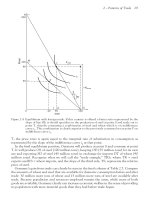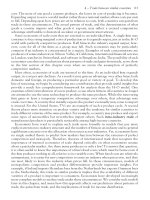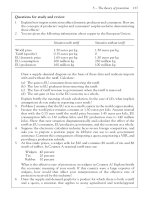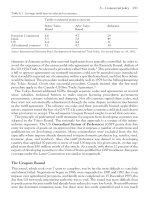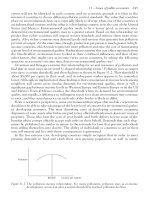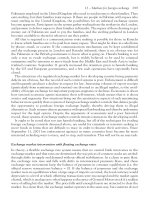Testbank 6th international economics
Bạn đang xem bản rút gọn của tài liệu. Xem và tải ngay bản đầy đủ của tài liệu tại đây (2.22 MB, 399 trang )
TEST BANK
To accompany
International Economics: Theory and Policy
Sixth Edition
Krugman and Obstfeld
Dr. Mitchell Kellman
The City College of The City University of New
York, and
The Graduate Center, The City University of New
York
And
Dr. Yochanan Shachmurove
The City College of The City University of New
York, and
The University of Pennsylvania
Contents
Chapter 1
Chapter 2
Chapter 3
Chapter 4
Chapter 5
Chapter 6
Chapter 7
Chapter 8
Chapter 9
Chapter 10
Chapter 11
Chapter 12
Chapter 13
Chapter 14
Chapter 15
Chapter 16
Chapter 17
Chapter 18
Chapter 19
Chapter 20
Chapter 21
Chapter 22
Page
Introduction
1
Labor Productivity and Comparative Advantage: The Ricardian Model 14
Specific Factors and Income Distribution
28
Resources and Trade: The Heckscher-Ohlin Model
41
The Standard Trade Model
56
Economies of Scale, imperfect Competition, and International Trade
70
International Factor Movements
82
The Instruments of Trade Policy
96
The Political Economy of Trade Policy
108
Trade Policy in Developing Countries
121
Strategic Trade Policy in Advanced Countries
133
National Income Accounting and the Balance of Payments
147
Exchange Rates and the Foreign Exchange Market:
An Asset Approach
164
Money, Interest Rates, and Exchange Rates
189
Price Levels and Exchange Rate in the Long Run
210
Output and Exchange Rate in the Short Run
237
Fixed Exchange Rates and Foreign Exchange Intervention
256
The International Monetary System, 1870 – 1973
278
Macroeconomic Policy and Coordination Under
Floating Exchange Rates
302
Optimum Currency Areas and the European Experience
324
The Global Capital Market: Performance and Policy Problems
346
Developing Countries: Growth, Crisis, and Reform
370
Chapter 1: Introduction
Multiple Choice Questions
1.
Historians of economic thought often describe ___________ written by _______
and published in __________ as the first real exposition of an economic model.
A.
"Of the Balance of Trade,” David Hume, 1776
B.
"Wealth of Nations," David Hume, 1758
C.
"Wealth of Nations," Adam Smith, 1758
D.
"Wealth of Nations," Adam Smith, 1776
E.
"Of the Balance of Trade," David Hume, 1758
Answer: E
2.
From 1959 to 2000,
A.
the U.S. economy roughly tripled in size.
B.
U.S. imports roughly tripled in size.
C.
the share of US Trade in the economy roughly tripled in size.
D.
U.S. Imports roughly tripled as compared to U.S. exports.
E.
U.S. exports roughly tripled in size.
Answer: C
3.
The United States is less dependent on trade than most other countries because
A.
the United States is a relatively large country.
B.
the United States is a "Superpower.".
C.
the military power of the United States makes it less dependent on
anything.
D.
the United States invests in many other countries
E.
many countries invest in the United States.
Answer: A
4.
Ancient theories of international economics from the 18th and 19th Centuries are:
A.
not relevant to current policy analysis.
B.
are only of moderate relevance in today's modern international economy.
C.
are highly relevant in today's modern international economy.
D.
are the only theories that actually relevant to modern international
economy.
E.
are not well understood by modern mathematically oriented theorists.
Answer: C
1
5.
An important insight of international trade theory is that when countries exchange
goods and services one with the other it
A.
is always beneficial to both countries.
B.
is usually beneficial to both countries.
C.
is typically beneficial only to the low wage trade partner country .
D.
is typically harmful to the technologically lagging country.
E.
tends to create unemployment in both countries.
Answer: B
6.
If there are large disparities in wage levels between countries, then
A.
trade is likely to be harmful to both countries.
B.
trade is likely to be harmful to the country with the high wages.
C.
trade is likely to be harmful to the country with the low wages.
D.
trade is likely to be harmful to neither country.
E.
trade is likely to have no effect on either country.
Answer: D
7.
Benefits of international trade are limited to
A.
tangible goods.
B.
intangible goods.
C.
all goods but not services.
D.
services.
E.
None of the above.
Answer: E
8.
Attempts to explain the pattern of international trade
A.
have been a major focus of international economists.
B.
have proven to be hopeless.
C.
have proven to be a trivial exercise.
D.
have been the preoccupation of economic development theorists.
E.
None of the above.
Answer: A
9.
Which of the following does not belong?
A.
NAFTA
B.
Uruguay Round
C.
World Trade Organization
D.
None Tariff Barriers
2
E.
None of the above.
Answer: D
10.
Cost-benefit analysis of international trade
A.
is basically useless.
B.
is empirically intractable.
C.
focuses attention on conflicts of interest within countries.
D.
focuses attention on conflicts of interests between countries.
E.
None of the above.
Answer: C
11.
An improvement in a country's balance of payments means a decrease in its
balance of payments deficit, or an increase in its surplus. In fact we know that a
surplus in a balance of payments
A.
is good.
B.
is usually good.
C.
is probably good.
D.
may be considered bad.
E.
is always bad.
Answer: D
12.
The study of exchange rate determination is relatively
A.
difficult.
B.
new and mathematical.
C.
old.
D.
obtuse.
E.
None of the above.
Answer: B
13.
The GATT was
A.
an international treaty.
B.
an international U.N. agency.
C.
an international IMF agency.
D.
a U.S. government agency.
E.
a collection of tariffs.
Answer: A
3
14.
The international debt crisis of early 1982 was precipitated when _____ could not
pay its international debts.
A.
Russia
B.
Mexico
C.
Brazil
D.
Malaysia
E.
China
Answer: B
15.
International economics can be divided into two broad sub-fields:
A.
macro and micro.
B.
developed and less developed.
C.
monetary and barter.
D.
international trade and international money.
E.
static and dynamic.
Answer: C
16.
A primary reason why nations conduct international trade is because of
differences in
A.
historical perspective.
B.
location.
C.
resource availabilities.
D.
tastes.
E.
incomes.
Answer: C
17.
International trade is sometimes used as a substitute for all of the following except
A.
international movements of capital.
B.
international movement s of labor.
C.
domestic production of the same goods or services.
D.
domestic production of different goods and services.
E.
None of the above.
Answer: D
4
18.
International trade forces domestic firms to become more competitive in terms of
A.
the introduction of new products.
B.
product design and quality.
C.
product reliability.
D.
product price.
E.
All of the above.
Answer: E
19.
The movement to free international trade is most likely to generate short-term
unemployment in which industries?
A.
Industries producing non-tradable goods
B.
Import-competing industries
C.
Export industries
D.
Import sectors
E.
None of the above.
Answer: B
20.
International trade is logically associated with which assumption?
A.
Resources are less mobile internationally than domestically.
B.
Resources are more mobile internationally than are goods.
C.
Imports should exceed exports.
D.
Exports should exceed imports.
E.
None of the above.
Answer: A
21.
Arguments for free trade are sometimes disregarded by the political process
because
A.
economists tend to favor highly protected domestic markets.
B.
economists have a universally accepted decisive power over the political
decision mechanism.
C.
maximizing consumer welfare may not be a chief priority for politicians.
D.
the gains of trade are of paramount concern to typical consumers.
E.
None of the above.
Answer: C
5
22.
Increased foreign competition tends to
A.
increase profits of domestic import-competing industries.
B.
place constraints on the wages of domestic workers.
C.
induce falling output per worker for domestic workers.
D.
intensity inflationary pressures at home
E.
None of the above.
Answer: B
23.
____________ is the ability of a firm to design, produce, and market goods and
services that are better and/or cheaper than those of other firms.
A.
Competitiveness
B.
Protectionism
C
Comparative advantage
D.
Interventionism
E.
None of the above.
Answer: A
24.
For a country to maximize its productivity in a global economy, it requires
A.
only imports.
B.
only exports.
C.
both exports and imports.
D.
neither exports nor imports.
E.
foreign direct investment.
Answer: C
25.
Proponents of free trade claim all of the following as advantages except
A.
relatively high wage levels for all domestic workers.
B.
a wider selection of products for consumers
C.
increased competition for world producers.
D.
the utilization of the most efficient production processes.
E.
None of the above.
Answer: A
26.
A firm's ____, relative to that of other firms, is generally regarded as the most
important determinant of competitiveness.
A.
income level
B.
tastes
C.
preferences
D.
productivity
6
E.
environmental regulation
Answer: D
27.
One likely effect of moving to free international trade is that
A.
a monopoly in the home market becomes an oligopoly in the world
market.
B.
an oligopoly in the home market becomes a monopoly in the world
market.
C.
a purely competitive firm becomes an oligopolist.
D.
a purely competitive firm becomes a monopolist.
E.
None of the above.
Answer: A
28.
International trade in goods and services tends to
A.
increase all domestic costs and prices.
B.
keep all domestic costs and prices at the same level.
C.
lessen the amount of competition facing home manufactures.
D.
increase the amount of competition facing home manufacturers.
E.
None of the above.
Answer: D
29.
The real income of domestic producers and consumers may be increased by
A.
technological progress, but not international trade.
B.
international trade, but not technological progress.
C.
neither technological progress nor international trade.
D.
both technological progress and international trade.
E.
None of the above.
Answer: D
30.
A sudden shift from import tariffs to free trade may cause short-term
unemployment in
A.
import competing industries.
B.
exporting industries.
C.
industries that neither import nor export.
D.
service industries
E.
None of the above.
Answer: A
7
31.
Empirical studies indicate that productivity performance is
A.
directly related to globalization of industries.
B.
inversely related to globalization of industries.
C.
not related to globalization of industries.
D.
Any of the above.
E.
None of the above.
Answer: A
32.
A closed economy is one in which
A.
imports exactly equal exports.
B.
domestic firms invest in foreign countries.
C.
the home economy is isolated from foreign trade or investment.
D.
All of the above.
E.
None of the above.
Answer: C
33.
The dominant trading nation in the world market since World War II was
A.
the United Kingdom.
B.
the United States.
C.
Japan.
D.
Germany.
E.
China.
Answer: B
34.
Empirical studies indicate that _______________ best enhances productivity
growth for local industries
A.
local competition
B.
cut-throat competition
C.
destabilizing competition
D.
global competition
E.
None of the above.
Answer: D
35.
High levels of openness are most likely associated with a country's
A.
political orientation.
B.
size.
C.
resource availability.
D.
historical association with foreign entangling alliances.
E.
None of the above.
8
Answer: B
9
Essay Questions
1.
It is argued that small countries tend have more open economies than large ones.
Is this empirically verified? What are the logical underpinnings of this argument?
Answer: Yes. They do not have sufficient resources to satisfy consumption needs; and
also do not have a sufficiently large market to enable their industries to avail themselves
of scale economy possibilities.
Another answer would rely on a location argument. Assume that the "natural" market for
any given plant is a circle with a radius of n miles with the plant at its center. Assuming
that the production plants are located randomly throughout the country, then the
probability that the typical circular market will encompass some foreign country is
greater the smaller is the country.
2.
It is argued that if a rich high wage country such as the United States were to
expand trade with a relatively poor and low wage country such as Mexico, then
U.S. industry would migrate south, and U.S. wages would fall to the level of
Mexico's. What do you think about this argument?
Answer: The student may think anything. The purpose of the question is to set up a
discussion, which will lead to the models in the following chapters.
3.
Some patterns of international trade are easier to explain than others. Give several
examples and explain.
Answer: Historical circumstance can explain some patterns such as the relatively large
trade flows from West Africa to France. The relatively sparse trade between countries
within South America seems curious.
4.
International trade tends to prove that international trade is beneficial to all
trading countries. However, casual observation notes that official obstruction of
international trade flows is widespread. How might you reconcile these two
facts?
Answer: Like question 2, this is meant to allow students to offer preliminary discussions
of issues, which will be explored in depth later in the book.
5.
It is argued that small countries tend have more open economies than large ones.
Is this empirically verified? What are the logical underpinnings of this argument?
Answer: Yes. They do not have sufficient resources to satisfy consumption needs; and
also do not have a sufficiently large market to enable their industries to avail themselves
of scale economy possibilities.
10
Another answer would rely on a location argument. Assume that the "natural" market for
any given plant is a circle with a radius of n miles with the plant at its center. Assuming
that the production plants are located randomly throughout the country, then the
probability that the typical circular market will encompass some foreign country is
greater the smaller is the country.
6.
It is argued that if a rich high wage country such as the United States were to
expand trade with a relatively poor and low wage country such as Mexico, then
U.S. industry would migrate south, and U.S. wages would fall to the level of
Mexico's. What do you think about this argument?
Answer: The student may think anything. The purpose of the question is to set up a
discussion, which will lead to the models in the following chapters.
7.
Some patterns of international trade are easier to explain than others. Give several
examples and explain.
Answer: Historical circumstance can explain some patterns such as the relatively large
trade flows from West Africa to France. The relatively sparse trade between countries
within South America seems curious.
8.
International trade tends to prove that international trade is beneficial to all
trading countries. However, casual observation notes that official obstruction of
international trade flows is widespread. How might you reconcile these two
facts?
Answer: Like question 2, this is meant to allow students to offer preliminary discussions
of issues, which will be explored in depth later in the book.
9.
International Trade theory is one of the oldest areas of applied economic policy
analysis. It is also an area for which data was relatively widely available very
early on. Why do you suppose this is the case?
Answer: In ancient times, public finance was not well developed. Most of the
population was not producing and consuming within well-developed market economies,
so that income and sales taxes were not efficient. One of the most convenient ways for
governments to obtain resources was to set up custom posts at borders and tax. Hence
international trade was of great policy interest to princes and kings, as was precise data of
their main tax base.
11
Quantitative/Graphing Problems
1.
The figure above is the Production Possibility Frontier (PPF) of Baccalia, where
only two products are produced, clothing and wine. In fact Baccalia is producing
on its PPF at point A. By and large the people of Baccalia are content, as both
their external and internal needs for warmth are satisfied in the most economically
efficient manner possible, given their available productive resources (and known
technology). How much wine is being produced? How much cloth? If a person
in this country wanted to purchase a liter of wine, what would be the price he or
she would have to pay?
Judging from what you learned in the previous paragraph, can you indicate at
which point (if at all) the Community Indifference Curve is tangent to the
Production Possibility Frontier? Explain your reasoning.
Answer:
6 million liters of wine are being produced.
3 million square yards of cloth are being produced.
The price of 1 liter of wine is one half of a square yard of cloth.
The tangency is at point A. We know this because otherwise the country would
not be producing at the point of maximum economic efficiency.
12
2.
One day, Baccalia joined the WTO and joined the Global Village. They
discovered that in the LWE (London Wine Exchange), 1 liter of wine is worth 1
square yard of cloth. What is the logical production point they should strive for?
Answer: 10 million liters of wine.
3.
They wish to enjoy to the fullest from the gains from trade, but are not willing to
give up imbibing even one drop of wine from the 6 million liters they consumed
in their original autarkic state. If their new consumption point is a point we shall
designate as point b, describe where this point would be found.
Answer: Vertically above point a
4.
Where is the Community Indifference Curve family of curves tangent to their new
Consumption Possibility Frontier?
Answer: At point b.
5.
How can you prove that Baccalia has in fact gained from the availability of trade,
and that their new situation is superior to the pre-trade situation (with which they
were quite content)?
Answer: The country was consuming at point a before trade. It is now consuming at
point b with trade. Point b represents a superior welfare combination of goods as
compared to point a, since at b the country has more of each of the goods.
13
Chapter 2: Labor Productivity and Comparative Advantage - The Ricardian Model
Multiple Choice Questions
1.
Countries trade with each other because they are _______ and because of ______.
A.
different, costs
B.
similar, scale economies
C.
different, scale economies
D.
similar, costs
E.
None of the above.
Answer: C
2.
Trade between two countries can benefit both countries if
A.
each country exports that good in which it has a comparative advantage.
B.
each country enjoys superior terms of trade.
C.
each country has a more elastic demand for the imported goods.
D.
each country has a more elastic supply for the supplied goods.
E.
Both C and D.
Answer: A
3.
The Ricardian theory of comparative advantage states that a country has a
comparative advantage in widgets if
A.
output per worker of widgets is higher in that country.
B.
that country's exchange rate is low.
C.
wage rates in that country are high.
D.
the output per worker of widgets as compared to the output of some other
product is higher in that country.
E.
Both B and C.
Answer: D
4.
In order to know whether a country has a comparative advantage in the
production of one particular product we need information on at least ____unit
labor requirements
A.
B.
C.
D.
E.
one
two
three
four
five
Answer: D
14
4.
A country engaging in trade according to the principles of comparative advantage
gains from trade because it
A.
is producing exports indirectly more efficiently than it could alternatively.
B.
is producing imports indirectly more efficiently than it could domestically.
C.
is producing exports using fewer labor units.
D.
is producing imports indirectly using fewer labor units.
E.
None of the above.
Answer: B
5.
Given the following information:
Unit Labor Requirements
Cloth
Widgets
10
20
60
30
Home
Foreign
A.
B.
C.
D.
E.
Neither country has a comparative advantage.
Home has a comparative advantage in cloth.
Foreign has a comparative advantage in cloth.
Home has a comparative advantage in widgets.
Home has a comparative advantage in both products.
Answer: B
6.
If it is ascertained that Foreign uses prison-slave labor to produce its exports, then
home should
A.
export cloth.
B.
export widgets.
C.
export both and import nothing.
D.
export and import nothing.
E.
All of the above.
Answer: A
15
7.
If the Home economy suffered a meltdown, and the Unit Labor Requirements in
each of the products quadrupled (that is, doubled to 30 for cloth and 60 for
widgets) then home should
A.
export cloth.
B.
export widgets.
C.
export both and import nothing.
D.
export and import nothing.
E.
All of the above.
Answer: A
8.
If wages were to double in Home, then Home should:
A.
export cloth.
B.
export widgets.
C.
export both and import nothing.
D.
export and import nothing.
E.
All of the above.
Answer: A
9.
If the world equilibrium price of widgets were 4 Cloths, then
A.
both countries could benefit from trade with each other.
B.
neither country could benefit from trade with each other.
C.
each country will want to export the good in which it enjoys comparative
advantage.
D.
neither country will want to export the good in which it enjoys
comparative advantage.
E.
both countries will want to specialize in cloth.
Answer: A
10.
Given the following information:
Home
Foreign
A.
B.
C.
D.
E.
Number of Units Produced by one Unit of Labor
Cloth
Widgets
10
20
60
30
Neither country has a comparative advantage.
Home has a comparative advantage in cloth.
Foreign has a comparative advantage in cloth.
Foreign has a comparative advantage in widgets.
Home has a comparative advantage in both products.
16
Answer: C
11.
The opportunity cost of cloth in terms of widgets in Foreign is if it is ascertained
that Foreign uses prison-slave labor to produce its exports, then home should
A.
export cloth.
B.
export widgets.
C.
export both and import nothing.
D.
export and import nothing.
E.
All of the above.
Answer: B
12.
If wages were to double in Home ,then Home should
A.
export cloth.
B.
export widgets.
C.
export both and import nothing.
D.
export and import nothing.
E.
All of the above.
Answer: B
13.
If the world equilibrium price of widgets were 4 Cloths, then
A.
both countries could benefit from trade with each other.
B.
neither country could benefit from trade with each other.
C.
each country will want to export the good in which it enjoys comparative
advantage.
D.
neither country will want to export the good in which it enjoys
comparative advantage.
E.
both countries will want to specialize in cloth.
Answer: A
14.
If the world equilibrium price of widgets were 40 cloths, then
A.
both countries could benefit from trade with each other.
B.
neither country could benefit from trade with each other.
C.
each country will want to export the good in which it enjoys comparative
advantage.
D.
neither country will want to export the good in which it enjoys
comparative advantage.
E.
both countries will want to specialize in cloth.
Answer: A
17
15.
In a two product two country world, international trade can lead to increases in
A.
consumer welfare only if output of both products is increased.
B.
output of both products and consumer welfare in both countries.
C.
total production of both products but not consumer welfare in both
countries
D.
consumer welfare in both countries but not total production of both
products.
E.
None of the above.
Answer: B
16.
As a result of trade, specialization in the Ricardian model tends to be
A.
complete with constant costs and with increasing costs.
B.
complete with constant costs and incomplete with increasing costs.
C.
incomplete with constant costs and complete with increasing costs.
D.
incomplete with constant costs and incomplete with increasing costs.
E.
None of the above.
Answer: B
17.
A nation engaging in trade according to the Ricardian model will find its
consumption bundle
A.
inside its production possibilities frontier.
B.
on its production possibilities frontier.
C.
outside its production possibilities frontier.
D.
inside its trade-partner's production possibilities frontier.
E.
on its trade-partner's production possibilities frontier.
Answer: C
18.
In the Ricardian model, if a country's trade is restricted, this will cause all except
which?
A.
Limit specialization and the division of labor.
B.
Reduce the volume of trade and the gains from trade
C.
Cause nations to produce inside their production possibilities curves
D.
May result in a country producing some of the product of its comparative
disadvantage
E.
None of the above.
Answer: C
18
19.
If a very small country trades with a very large country according to the Ricardian
model, then
A.
the small country will suffer a decrease in economic welfare.
B.
the large country will suffer a decrease in economic welfare.
C.
the small country will enjoy gains from trade.
D.
the large country will enjoy gains from trade.
E.
None of the above.
Answer: C
20.
If the world terms of trade for a country are somewhere between the domestic cost
ratio of H and that of F, then
A.
country H but not country F will gain from trade.
B.
country H and country F will both gain from trade.
C.
neither country H nor F will gain from trade.
D.
only the country whose government subsidizes its exports will gain.
E.
None of the above.
Answer: B
21.
If the world terms of trade equal those of country F, then
A.
country H but not country F will gain from trade.
B.
country H and country F will both gain from trade.
C.
neither country H nor F will gain from trade.
D.
only the country whose government subsidizes its exports will gain.
E.
None of the above.
Answer: A
22.
If the world terms of trade equal those of country ,F then
A.
country H but not country F will gain from trade.
B.
country H and country F will both gain from trade.
C.
neither country H nor F will gain from trade.
D.
only the country whose government subsidizes its exports will gain.
E.
None of the above.
Answer: E
19
23.
If a production possibilities frontier is bowed out (concave to the origin), then
production occurs under conditions of
A.
constant opportunity costs.
B.
increasing opportunity costs.
C.
decreasing opportunity costs.
D.
infinite opportunity costs.
E.
None of the above.
Answer: B
24.
If two countries have identical production possibility frontiers, then trade between
them is not likely if
A.
their supply curves are identical.
B.
their cost functions are identical.
C.
their demand conditions identical.
D.
their incomes are identical.
E.
None of the above.
Answer: E
25.
If two countries have identical production possibility frontiers, then trade between
them is not likely if
A.
their supply curves are identical.
B.
their cost functions are identical.
C.
their demand functions differ.
D.
their incomes are identical.
E.
None of the above.
Answer: C
26.
The earliest statement of the principle of comparative advantage is associated
with
A.
David Hume.
B.
David Ricardo.
C.
Adam Smith.
D.
Eli Heckscher.
E.
Bertil Ohlin.
Answer: B
20
27.
If one country's wage level is very high relative to the other's (the relative wage
exceeding the relative productivity ratios), then if they both use the same currency
A.
neither country has a comparative advantage.
B.
only the low wage country has a comparative advantage.
C.
only the high wage country has a comparative advantage.
D.
consumers will still find trade worth while from their perspective.
E.
None of the above.
Answer: E
28.
If one country's wage level is very high relative to the other's (the relative wage
exceeding the relative productivity ratios), then
A.
it is not possible that producers in each will find export markets profitable.
B.
it is not possible that consumers in both countries will enhance their
respective welfares through imports.
C.
it is not possible that both countries will find gains from trade.
D.
it is possible that both will enjoy the conventional gains from trade.
E.
None of the above.
Answer: D
29.
The Ricardian model is based on all of the following except
A.
only two nations and two products.
B.
no diminishing returns.
C.
labor is the only factor of production.
D.
product quality varies among nations.
E.
None of the above.
Answer: D
30.
Ricardo's original theory of comparative advantage seemed of limited real-world
value because it was founded on the
A.
labor theory of value.
B.
capital theory of value.
C.
land theory of value.
D.
entrepreneur theory of value.
E.
None of the above.
Answer: A
21
31.
According to Ricardo, a country will have a comparative advantage in the product
in which its
A.
labor productivity is relatively low.
B.
labor productivity is relatively high.
C.
labor mobility is relatively low.
D.
labor mobility is relatively high.
E.
None of the above.
Answer: B
32.
In a two-country, two-product world, the statement "Germany enjoys a
comparative advantage over France in autos relative to ships" is equivalent to
A.
France having a comparative advantage over Germany in ships.
B.
France having a comparative disadvantage compared to Germany in autos
and ships.
C.
Germany having a comparative advantage over France in autos and ships.
D.
France having no comparative advantage over Germany.
E.
None of the above.
Answer: A
33.
Assume that labor is the only factor of production and that wages in the United
States equal $20 per hour while wages in Japan are $10 per hour. Production
costs would be lower in the United States as compared to Japan if
A.
U.S. labor productivity equaled 40 units per hour and Japan's 15 units per
hour.
B.
U.S. productivity equaled 30 units per hour whereas Japan's was 20.
C.
U.S. labor productivity equaled 20 and Japan's 30.
D.
U.S. labor productivity equaled 15 and Japan's 25 units per hour.
E.
None of the above.
Answer: A
34.
If the United States’ production possibility frontier was flatter to the widget axis,
whereas Germany's was flatter to the butter axis, we know that
A.
the United States has no comparative advantage
B.
Germany has a comparative advantage in butter.
C.
the U.S. has a comparative advantage in butter.
D.
Not enough information is given.
E.
None of the above.
Answer: B
22
35.
Suppose the United States' production possibility frontier was flatter to the widget
axis, whereas Germany's was flatter to the butter axis. We now learn that the
German mark is sharply depreciated against the U.S. dollar. We now know that
A.
the United States has no comparative advantage
B.
Germany has a comparative advantage in butter.
C.
the United States has a comparative advantage in butter.
D.
Not enough information is given.
E.
None of the above.
Answer: B
36.
Suppose the United States' production possibility frontier was flatter to the widget
axis, whereas Germany's was flatter to the butter axis. We now learn that the
German wage doubles, but U.S. wages do not change at all. We now know that
A.
the United States has no comparative advantage.
B.
Germany has a comparative advantage in butter.
C.
the United States has a comparative advantage in butter.
D.
Not enough information is given.
E.
None of the above.
Answer: B
23




